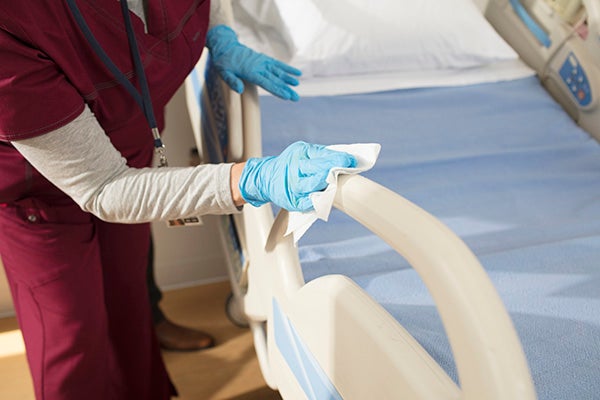CloroxPro Blog – Professional Cleaning and Disinfection Insights
A blog from industry experts devoted to public health awareness, best practices, and the role of environmental cleaning and disinfection, to promote safer, healthier public spaces.
What’s Your Outbreak Protocol? https://www.cloroxpro.ca/blog/whats-your-outbreak-protocol/ March 9, 2020 August 18, 2020 https://www.cloroxpro.ca/wp-content/uploads/2020/07/Outbreak-protocol-1.jpgWhat’s Your Outbreak Protocol?
Communicable diseases cause a significant burden on society in terms of healthcare expenditure and health impact on individuals.1 A Canadian analysis suggests that hospital outbreaks of influenza occur on a regular basis and contribute to overall morbidity and mortality.2
Additionally, healthcare-associated infections (HAIs) affect 4% to 10% of patients and can result in significant harm to patients and healthcare workers.3,4 Healthcare facilities are complex environments where the provision of care to large numbers of patients can result in the contamination of surfaces and equipment with harmful microorganisms.5
Outbreaks are costly
The costs associated with outbreaks can be considerable and often include:6
- Costs associated with utilizing additional staff (such as nurses, healthcare workers, environmental services staff, etc.);
- Microbiological testing;
- Ward and bed closures;
- Loss of revenue from private room accommodation;
- Increased use of supplies (including personal protective equipment);
- Increased use of medications, including preventative vaccinations.
Outbreaks happen
The ongoing novel coronavirus disease (COVID-19; formerly known as 2019-nCoV) outbreak originating in China, but now spreading worldwide, including Canada, serves as a timely reminder of the importance of adhering to strict infection prevention protocols for outbreak situations, especially at healthcare facilities.
Plan to prevent
According to the 2020 report Best Practices for Prevention, Surveillance and Infection Control Management of Novel Respiratory Infections in All Health Care Settings, by the Provincial Disease Advisory Committee (PIDAC), there are a number of factors that can influence outbreaks, including:7
- Adherence to infection prevention and control (IPAC) protocols;
- Hand hygiene, including the use of alcohol-based hand rub and hand washing;
- Assessment of the risk of infection transmission and the appropriate use of personal protective equipment, including correct selection, safe application, removal and disposal;
- Healthcare providers should be apprehensive when screening anyone with a new onset of antimicrobial-resistant infection symptoms or other symptoms characteristic of a novel infection;
- Anyone accompanying a patient who is entering a healthcare setting should also be screened;
- Appropriate cleaning and/or disinfection of healthcare equipment, supplies and surfaces or items in the healthcare environment;
- The use of Health Canada-approved disinfectants;
- Individual staff are responsible for keeping patients, healthcare workers and themselves and coworkers safe. This is in addition to employer and supervisor responsibilities for worker safety.
Be healthcare clean
“Healthcare clean” is an approach to cleaning that aims to reduce or eliminate microbial contamination of all surfaces and equipment within the healthcare environment.8

In a 2018 report, PIDAC recommended that enhanced cleaning and disinfection are often required during outbreaks when environmental contamination and subsequent transmission is known to be related to the organism suspected of causing the outbreak (e.g., norovirus, Clostridium difficile).5 There are multiple studies demonstrating how outbreaks caused by antibiotic-resistant organisms were controlled or stopped following the adoption of enhanced cleaning and disinfection approaches.9,10
In an effort to keep up, the technology used to perform environmental cleaning continues to evolve. No-touch disinfection systems use chemical disinfectants or physical agents to disinfect surfaces and can supplement, but not replace, manual cleaning and disinfection.5
CloroxPro™ can help.
Our infection control specialists are equipped to review your current outbreak protocols, recommend products based on clinical evidence and customize your protocols to the needs of your facility.
Get in touch
To get more information either email us, or click on the Contact Us tab for more options.
References:
- Diener A & Dugas J. Inequality-related economic burden of communicable diseases in Canada. Can Commun Dis Rep Suppl 2016;42:S1-S7. https://www.ncbi.nlm.nih.gov/pubmed/29770033
- Murti M, et al. Influenza outbreaks in Ontario hospitals, 2012-2016. Can Commun Dis Rep Suppl 2018;44(9):201-5. https://www.ncbi.nlm.nih.gov/pubmed/31015810
- Magill SS, et al. Multistate point-prevalence survey of health care-associated infections. N Engl J Med 2014;370(13):1198-208. https://www.ncbi.nlm.nih.gov/pubmed/24670166
- Taylor G, et al. Assessing the magnitude and trends in hospital acquired infections in Canadian hospitals through sequential point prevalence surveys. Antimicrob Resist Infect Control 2016;5(19). https://www.ncbi.nlm.nih.gov/pmc/articles/PMC4875760/
- Ontario Agency for Health Protection and Promotion (Public Health Ontario), Provincial Infectious Diseases Advisory Committee. Best practices for environmental cleaning for prevention and control of infections in all health care settings. 3rd ed. Toronto, ON: Queen’s Printer for Ontario; 2018. https://www.publichealthontario.ca/-/media/documents/bp-environmental-cleaning.pdf
- Dik J-H H, et al. (2016) Cost-analysis of seven nosocomial outbreaks in an academic hospital. PLoS ONE 11(2):e0149226. https://journals.plos.org/plosone/article?id=10.1371/journal.pone.0149226
- Ontario Agency for Health Protection and Promotion (Public Health Ontario), Provincial Infectious Diseases Advisory Committee. Best practices for prevention, surveillance and infection control management of novel respiratory infections in all health care settings. 1st revision. Toronto, ON: Queen’s Printer for Ontario; 2020. https://www.publichealthontario.ca/-/media/documents/bp-novel-respiratory-infections.pdf?la=en
- Gauthier J. “Hospital clean” versus “construction clean” – is there a difference? Can J Infect Control 2004;19(3):150-2. https://www.ncbi.nlm.nih.gov/pmc/articles/PMC3892556/
- Delgado Naranjo J, et al. Control of a clonal outbreak of multidrug-resistant Acinetobacter baumannii in a hospital of the Basque country after the introduction of environmental cleaning led by the systematic sampling from environmental objects. Interdiscip Perspect Infect Dis 2013;2013:582831. https://www.ncbi.nlm.nih.gov/pmc/articles/PMC3892556/
- de Lassence A, et al. Control and outcome of a large outbreak of colonization and infection with glycopeptide-intermediate Staphylococcus aureus in an intensive care unit. Clin Infect Dis 2006;42(2):170-8. https://www.ncbi.nlm.nih.gov/pubmed/16355325
